| 1 | The rare Middle Eastern bear |
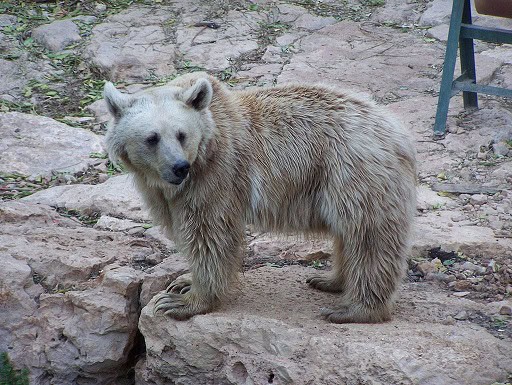
The giant double continent of Eurasia has 8 official brown bear subspecies, although the number is up for debate. Common ones include the Eurasian (or European) brown bear and the East Siberian brown bear, and rare ones include the Tibetan blue bear and critically endangered Gobi bear. The Syrian brown bear has the distinction of being the smallest and lightest colour on average. This is the Middle East’s own bear, a species which still occasionally interacts with venomous vipers and herds of camels, though never on film.
The Syrian brown bear weighs 500 pounds on average, far below a grizzly bear or Kodiak. Its fur can be brown, but is most commonly a light sandy colour or blond, with a darker stripe on its back just below the neck. Others are multicoloured, with brown and blond hairs intermixed, like this bear caught on an Armenian camera trap in 2013.
The higher the bear’s altitude, the blonder its fur tends to be, and the legs are normally darker than the rest of the body. While blond grizzlies are occasionally sighted in Alaska, particularly in Denali, Syrian brown bears are the only bear to be consistently blond. They’re also the only subspecies to have white claws instead of black, outside of a small population pool in Siberia. Syrian brown bears have a similar diet to other brown bears, including nuts, roots and meat when they can get it (as there’s no salmon in the middle east).
| 2 | Extinct in Syria itself |
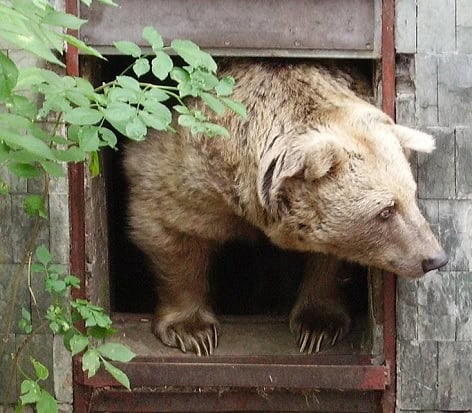
Despite their name, Syria no longer has a breeding population of this bear. By the 1880s, bears were already rare, confined mostly to Syria’s tallest peak Mount Hermon and the surrounding woodlands. The last concrete evidence was a 1955 report which mentioned bear paws and skins for sale in Syrian marketplaces.
Likewise, the Syrian brown bear is wiped out in Israel, Jordan and Palestine, partly due to encroaching on human settlements and military exercises, and partly due to hunting for superstitious folk remedies like bear fat. It’s listed as critically endangered, but neither the WWF nor IUCN has an official estimate as to how many bears are left, unlike the Gobi bear at just 25 individuals.
As of 2021, the Syrian brown bear survives in Iran, Iraq, Turkey, and Armenia. In Iran, they’re in serious trouble from poachers, as their skins sell for $2000 on Tehran marketplaces. With economic sanctions crippling the country, villagers are desperate for any income. Compared to other bears, they still love rugged mountains, but spend more time inhabiting woods, such as deciduous and conifer in north-east Turkey and the dry forests of east Anatolia.
Unlike grizzly bears, Syrian brown bears are small enough to hibernate in hollow trees, which in America, is only the domain of black bears. This means that deforestation is another threat to these blond bears. Generally, it’s accepted that Syrian brown bears are endangered, but not critically so.
| 3 | Wojtek the military bear |
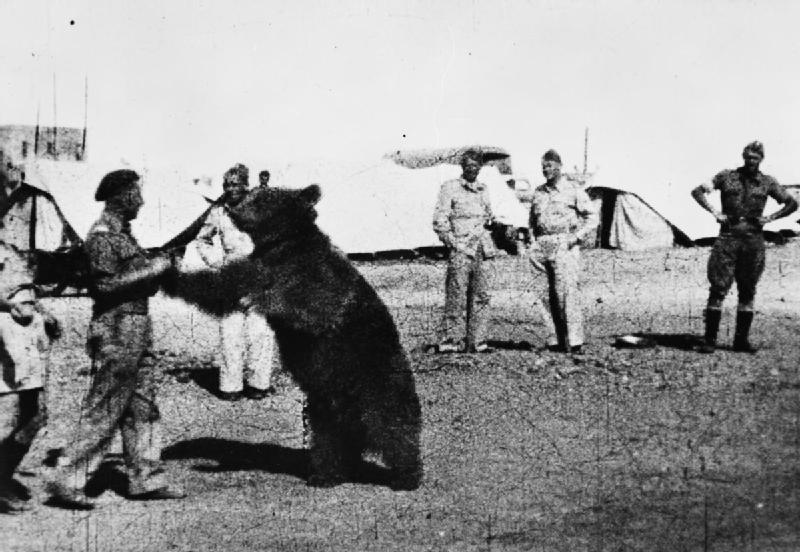
By far the most famous Syrian brown bear, and probably in the top 5 of famous bears overall, is Wojtek the soldier bear. He was discovered as a young cub in 1942, by recently freed Polish prisoners from a Soviet gulag who were marching across the Iraqi desert to start a new life as soldiers. They bought him from a poor boy by a railway station, using Persian coins and a Swiss army knife. Soon, the young cub was wrestling with the Polish solders, drinking beer, and smoking cigarettes, or swallowing the cigarettes whole.
Wojtek would sleep in the same tent as training soldiers, and when the Polish squadron were summoned to Egypt, the British boat wouldn’t allow Wojtek aboard, as he was classed as an animal. So naturally, they gave him the military rank of Private and an official code number.
By in 1943, he was promoted to corporal and helped to carry artillery shells in the battle of Monte Cassino near Rome. British soldiers swore for years afterwards that they’d witnessed a bear carrying shells, to the disbelieving smiles of their amused families. One day in Egypt, Wojtek ran around the beach scaring the sunbathing ladies. He also caught a thief hiding in the showers, who screamed so loudly that the guards ran in instantly.
In 1945, peace broke out. Wojtek spent 1.5 years in the Scottish town of Hutton, where the Polish squadron delisted, not wishing to face Stalin. Ultimately, he spent the last 20 years of his life in Edinburgh zoo, where he became stiff and depressed. But when old comrades visited and spoke in Polish, he would stand on his hind legs and salute like the good old days. Unusually for a Syrian brown bear, Wojtek was the standard brown colour.
| 4 | Very common in zoos |

When reading news stories about the latest bear antics, it’s surprisingly common to see that a Syrian brown bear was responsible. The subspecies is overrepresented (in a good way) in captivity worldwide, partly because of a plan hatched by two German zoos in Gotha and Heidelberg to re-establish Syrian brown bears in other zoos, to protect the future of the species.
For example, Jenny the Syrian brown bear wowed youtubers in January 2021 when she ran around a yard full of 2 foot deep virgin snow, so quickly that she seemed to have downed a monster energy drink. She tried to play with another blond bear, who gave it a half hearted attempt before the manic Jenny ran through a play tunnel and hugged a tree. This was the Orphaned Bear Centre in New York, which also contains Amy, Jenny’s bear best friend. Jenny’s favourite food is peanuts, while Amy loves grapes and is supposedly the smartest bear in the park.
England is no exception, as on January 23th 2020, three 2 year old Syrian brown bear cubs were separated from their mother in the Swiss Zoo du Servion, as would happen in the wild. Then they began the long journey to Hamerton zoo in Cambridge. They’re the only Syrian brown bears on UK soil. Brothers Jaiko and Newton are shy and bold respectively, while sister Laika favours a noisy approach.
Another headline was when Mango, a 19 year old Syrian brown bear in an Israeli zoo, had an operation to fix a sudden hind leg paralysis. His head was propped up on a pillow wrapped in a garbage bag, his fur shaved off his back, and body cut open for 6 hours while they fixed a ruptured disc between vertebrae two and three.
| 5 | 2006: rediscovered in Iraq |
In Iraq, the Syrian brown bear never went extinct, but by August 2003, sightings had been rare for a while. According to an IUCN newsletter, they were believed to exist in the north-east Kurdistan mountains, but “little information has been available for quite some time“. They were also concerned about the impact of the still-raging Iraq war, with insurgents camping out in the bear’s mountain habitat.
These concerns were washed away in mid-February 2006, thanks to one corporal Chuck Ridings of the US military. It was 8:30pm, and Ridings was conducting a routine flying mission over the arid badlands, featuring a pilot and a gunner on the left and right flanks of the plane, while Ridings assisted with navigation. He was also tasked with watching an infrared scanner for enemy insurgents, which showed up on video as different shades of green, like The Matrix or a 1980s computer monitor.
Ridings had encountered bears back in the US, and as they reached a large lake, he noticed a familiar sheen and rear wiggle from a giant animal, running up a slope on the north shore. He peered closer, and suddenly exclaimed “that’s a bear!”. He knew it wasn’t a camel or goat, because he’d seen them before too.
Ridings grabbed the camera controls and kept them fixed on the bear. The plane was flying in strict formation, but Bill the pilot leaned to the right to allow Ridings to watch the bear for 20 seconds. In the excitement, Ridings forgot to snap a photograph, which he later regretted.
| 6 | Confirmed in Iraq |
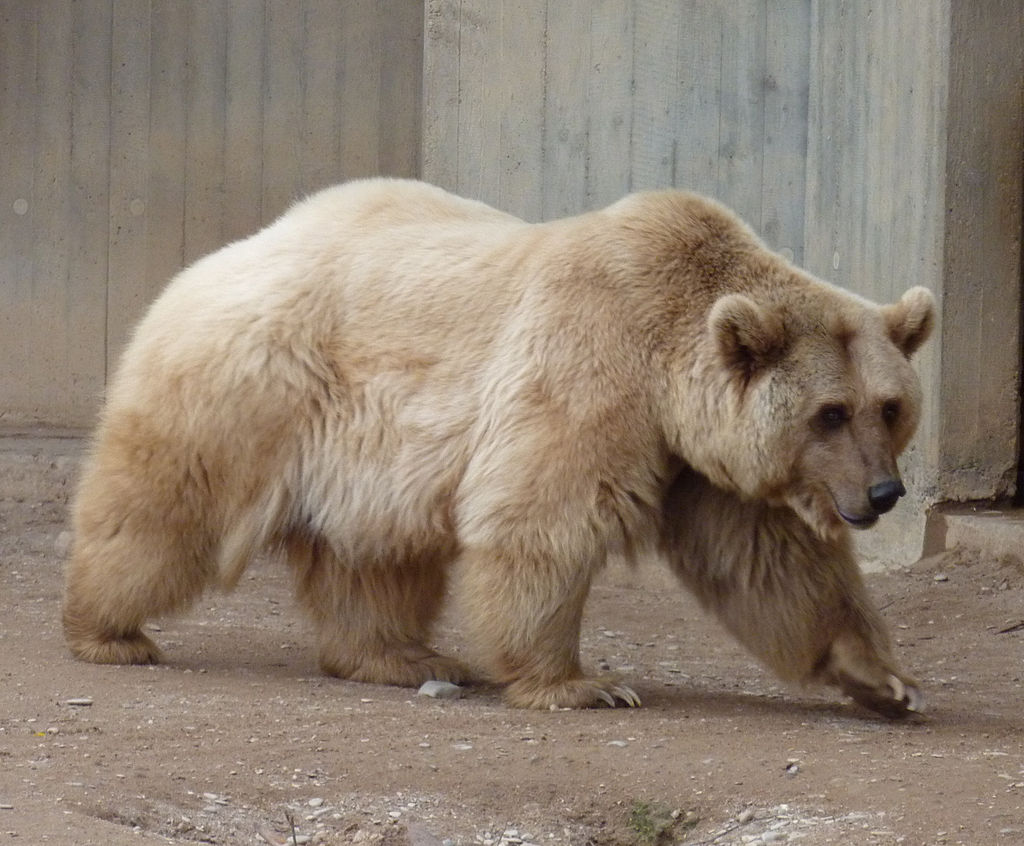
Later, the team discussed the sightings amongst themselves. They were shocked – none of them had heard of bears in Iraq before. When they entered camp that night, and told their squadron, there was disbelief, as tall tales were abundant among the Iraq-based US troops.
Undeterred, Ridings and his comrades searched for “bear sightings in Iraq” on google and found the bearbiology.org website (which is still online), which mentioned the Bear Specialist Group Coordinating Committee. Rydings picked a member at random and contacted them. 2 days later, they received a “very interested” request from the Committee for more information. What colour was the bear, the experts asked, and how big was it? Rydings said that his team felt ecstatic.
3 months later, an official report by the IUCN described the soldiers’ account as reliable, after a long email exchange. It was now official that bears lived on in Iraq. Better, they expected the soldiers’ sighting to have been by the Turkish border, in the bear heartlands, but it had actually been further south in Iraq, on the limits of the bears’ old range.
The bears were being adventurous, and 2010 saw more evidence for Syrian bears in Iraq when biologists surveyed 30 locations in the mountainous Kurdistan region of the northeast. 10 of them reported heavy bear sightings, including killings by hunters, with some having footage on their mobile phones.
| 7 | A heartwarming story |
Disney might think they’ve invented the concept, but the truth is that every country has at least one true story of animals adopting human children for no reason other than the goodness of their heart.
Spanish boy Marcos Pantoja was raised by wolves for 12 years and continued to walk on all fours. Hopes were raised briefly in 2019 when a North Carolina toddler claimed to have been cared for by a loving black bear mother in the forest, pulling him free from a bush he was stuck in. Unfortunately, the authorities announced that there was no evidence, but never fear, because Syrian brown bears are near.
In October 2001, a husband and wife of the nomadic Lomi tribes were walking home from their wheat fields in Lorena Province, western Iran, a cool forested region. They entered the tent, and realised with shock that their 3 year old toddler was missing. They searched the settlements, with no luck. 3 days passed, before their heads turned to the mountains. Surely, the toddler couldn’t have got that far.
Nevertheless, some local men set out and discovered a bear den. Inside was the toddler. He was completely healthy, and better, he appeared to have been breastfed. The kindly mother bear had nursed the stricken child. There was no mention of whether the mother bear had cubs of her own. One possibility is that they’d all died and the bear still had some motherly love to give.
| 8 | 2004 sighting in Syria |
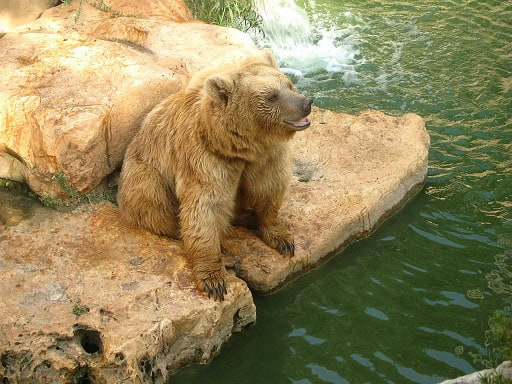
Despite its name, the Syrian brown bear has been extinct in Syria since the early 20th century. The bears were never the plump, well fed salmon gorgers of Alaska, and over-hunting was the finishing blow. But in January 2004, tracks in the snow were photographed for the first time in decades, by a researcher called Issam Hajjar. Picture proof showed footprints at the top of a snowy ridge around 1900 metres in altitude.
The anti-Lebanon mountains are a long range which mostly lies in Syria, and forms most of the border with Lebanon. These mountains are full of smugglers, but more importantly, they peak at 2814 metres, and consequently, it’s common for these Syrian mountains to be capped with snow in November to March, or even low levels if a serious injection of northerly air comes south from Siberia.
Bear biologists confirmed that the paw prints were of a bear. Did bears secretly survive in Syria? Or was it a lone male straying from Turkey, which was destined to die after a few hard months of struggling to find food? They didn’t rule out the bear finding a snug cave to survive in, and in February 2011, 3 much larger sets of tracks were observed in a similar snowy area. The area was plentiful in wild juniper and human fruit farms, but surely, farmers would have noticed if a bear was pillaging. Nevertheless, biologists confirmed the paw prints as a bear’s.
| 9 | More Syrian whispers |
A more mysterious “encounter” came on January 14th 2015, when a farmer hiking in the mountains snapped a picture of a blond-white animal. It was 50km north of the 2011 paw prints, and closely resembled a bear. However, the South Asian Brown Bear Expert team leaned towards it being a dog, and the locals, believing it to be a hyena, claimed to have stalked the now mythical animal and killed it. Hyenas are common in the anti-Lebanon mountains, and it’s unlikely that they would mistake it.
The picture also shows a hand plough for scale, and the animal looks too small for a bear, but a small female is a possibility – Syrian brown bears are one of the smallest subspecies to begin with. Biologists speculated that ironically, the Syrian civil war (which started in March 2011) was protecting the bears’ habitat, by keeping hunters from venturing out without caution.
For similar reasons, the black bears of Mexico have recovered significantly in neighbourhoods terrorised by drug running cartels. We at Bear Informer believe that it looks closest to a brown bear – check out the picture on page 8 here.
Luckily, there’s no proof that this “bear” was killed by the villagers, or that it was the same bear as 2011 and 2004. The prospects for Syrian brown bears in their homeland are looking up.
| 10 | Modern situtation |
As of 2024, it’s a mixed bag for the Syrian brown bear, but this subspecies isn’t quite on the precipice of extinction. Half of the Iraqi population seems to care deeply for the bears, while the other half regards them as hunting fodder. There was great outcry in 2018 when army troops came across a bear sleeping, and shot it at point blank range. They later posted pictures of themselves smiling behind the corpse, and were widely condemned by conservationists.
But 1 year earlier, the first brown bear in 60 years was seen in Lebanon. It was roaming the Lebanese side of the anti-Lebanon mountains – could it have been related to the Syrian bear from 2004 and 2011? The video is fuzzy on the level of bigfoot sightings, but it’s unmistakably a mother bear and cubs.
2021 saw the most shambolic conservation attempt ever, when 6 Syrian brown bears were rescued from captivity in the houses of cruel Iraqis. After rehabilitation, their cages were strapped to the backs of cars and driven high into the mountains. On a snowy ridge with the sun shining, trainers fed their beloved bears with a last gulp of water, and opened the cages, releasing them for freedom. Unfortunately, a crowd of 200 Iraqi locals gathered to watch.
The mood was jubilant, but as one bear left its cage, it turned on its saviours! It started chasing the crowds around the ridge, causing everyone to run around like headless chickens. The safety restrictions were laughable, as the cheering men and women were almost close enough to give the bear a stroke and a pat of encouragement. It seemed to be more playful than murderous though, or more of a practical joker, as after several sheepdog-style runs around the ridge, it took the hint from its trainers and wandered downhill into a patch of snow, never to return. This was one of the best bear videos in years.

Leave a Reply